Systematik der Dinosaurier

Die Dinosaurier sind ein Taxon der Archosaurier innerhalb der Sauropsiden (Sauropsida) bzw. Reptilien (Reptilia). Gemeinsam mit ihrer Schwestergruppe, den Flugsauriern (Pterosauria), bilden sie das Taxon der Ornithodira. Diese Systematik der Dinosaurier wurde nach den unter Literatur, Einzelnachweise und Weblinks aufgeführten Quellen erstellt.
Nach der 1887 durch Harry Govier Seeley[1] vom King’s College London eingeführten und lange prägenden Systematik wurden Dinosaurier in die beiden Ordnungen beziehungsweise Entwicklungslinien Echsenbeckensaurier (Saurischia) und Vogelbeckensaurier (Ornithischia) unterteilt. In einer phylogenetischen Studie aus dem Jahr 2017, basierend auf der detaillierten Analyse von 74 Taxa und 457 Merkmalen, schlagen die Paläontologen Matthew G. Baron, David B. Norman und Paul M. Barrett eine neue Systematik vor, die den Dinosaurier-Stammbaum radikal verändert.[2][3][4][5] Demnach bestehen die Dinosaurier aus den beiden Entwicklungslinien Saurischia und Ornithoscelida. In der Klade Ornithoscelida (gr. skelis=Bein), die Thomas Henry Huxley bereits 1880 so benannt hatte,[6] werden die Vogelbeckensaurier und die Theropoden als Schwestergruppen vereint. Die Klade Saurischia wird neu definiert und umfasst die beiden Schwestergruppen Sauropodomorpha und Herrerasauridae:
| Dinosauria |
| ||||||||||||||||||
Vogelbeckendinosaurier (Ornithischia)
[Bearbeiten | Quelltext bearbeiten]


- Abrictosaurus
- Echinodon
- Fruitadens
- Heterodontosaurus
- Lanasaurus
- Lycorhinus
- Manidens
- Pegomastax
- Tianyulong



- Huayangosauridae
- Stegosauridae
- Stegosauria incertae sedis






- Ankylosauridae
- Nodosauridae
- Ankylosauria incertae sedis und nomina dubia


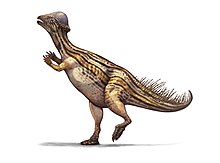
- Ferganocephale (umstritten)
- Stenopelix (umstritten)
- Wannanosaurus
- Yaverlandia (umstritten)
- Goyocephala
- Goyocephale
- Homalocephaloidea

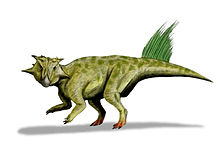




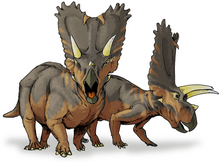

- Yinlong
- Chaoyangsauridae (evtl. in Neoceratopsia?)
- Psittacosauridae
- Neoceratopsia





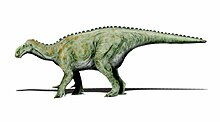





- Agilisaurus
- Alocodon
- Anabisetia
- Atlascopcosaurus
- Bugenasaurua
- Drinker
- Fulgurotherium
- Gasparinisaura
- Hypsilophodon
- Jeholosaurus
- Leaellynasaura
- Notohypsilophodon
- Orodromeus
- Othnielia
- Parksosaurus
- Qantassaurus
- Thescelosaurus
- Yandusaurus
- Zephyrosaurus
- Iguanodontia
- Rhabdodon
- Talenkauen[21]
- Tenontosaurus
- Zalmoxes
- Dryomorpha
- Dryosauridae
- Ankylopollexia
- Iguanodontoidea
- Altirhinus
- Craspedodon
- Eolambia
- Equijubus
- Fukuisaurus
- Iguanodon
- Jinzhousaurus
- Lurdusaurus
- Muttaburrasaurus
- Nanyangosaurus
- Ouranosaurus
- Probactrosaurus
- Protohadros
- Shuangmiaosaurus
- Hadrosauridae
Echsenbeckendinosaurier (Saurischia)
[Bearbeiten | Quelltext bearbeiten]

- Herrerasauridae
- Eoraptor
- Guaibasaurus
- Saturnalia
- Saurischia incertae sedis
- Sauropodomorpha
- Theropoda














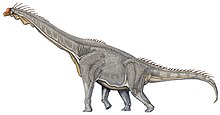

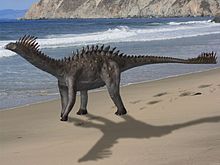

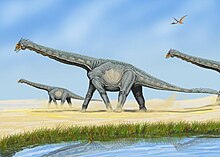




- Blikanasaurus
- Gongxianosaurus
- Isanosaurus
- Kotasaurus
- Ohmdenosaurus
- Pulanesaura
- Spinophorosaurus
- Vulcanodontidae
- Sauropoda incertae sedis
- Eusauropoda
- Barapasaurus
- Chuanjiesaurus
- Eomamenchisaurus
- Haplocanthosaurus
- Lourinhasaurus
- Mamenchisaurus
- Omeisaurus
- Shunosaurus
- Tehuelchesaurus
- Tienshanosaurus
- Tonganosaurus
- Yuanmousaurus
- Cetiosauridae
- Eusauropoda incerta sedis
- Neosauropoda
- Diplodocoidea
- Suuwassea
- Rebbachisauridae
- Dicraeosauridae
- Diplodocidae
- Apatosaurus = Brontosaurus
- Barosaurus
- Diplodocus
- Diplodocoidea incerta sedis
- Macronaria
- Atlasaurus
- Bellusaurus
- Europasaurus
- Jobaria
- Macronaria incerta sedis
- Camarasauromorpha
- Camarasauridae
- Titanosauriformes
- Astrodon
- Australodocus[28]
- Lapparentosaurus
- Ornithopsis
- Pelorosaurus
- Wintonotitan[29]
- Familie Brachiosauridae
- Familie Huanghetitanidae
- Familie Euhelopodidae
- Titanosauria[32]
- Adamantisaurus[33]
- Aegyptosaurus
- Agustinia
- Amargatitanis[34]
- Andesaurus
- Argentinosaurus
- Argyrosaurus
- Austrosaurus
- Baurutitan[35]
- Chubutisaurus
- Epachthosaurus
- Gobititan[36]
- Huabeisaurus
- Janenschia
- Karongasaurus[37]
- Ligabuesaurus[38]
- Maxakalisaurus[39]
- Phuwiangosaurus
- Sonidosaurus[40]
- Tangvayosaurus
- Uberabatitan[41]
- Venenosaurus
- Lithostrotia
- Aeolosaurus
- Alamosaurus
- Ampelosaurus
- Antarctosaurus
- Atsinganosaurus[42]
- Bonitasaura[43]
- Borealosaurus[44]
- Diamantinasaurus
- Futalognkosaurus
- Gondwanatitan
- Isisaurus[45]
- Iuticosaurus[46]
- Jainosaurus
- Jiangshanosaurus
- Laplatasaurus
- Lirainosaurus
- Magyarosaurus
- Malawisaurus
- Mendozasaurus[47]
- Mongolosaurus
- Muyelensaurus[48]
- Nemegtosaurus
- Paralititan
- Pellegrinisaurus
- Puertasaurus[49]
- Quaesitosaurus
- Rapetosaurus
- Rinconsaurus[50]
- Rocasaurus
- Traukutitan[51]
- Trigonosaurus
- Saltasauridae
- Nomina dubia (zweifelhafte Gattungen)
- Diplodocoidea



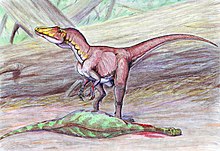



- Coelophysoidea
- Zupaysaurus
- Dilophosauridae
- Neoceratosauria
- Tetanurae
- Chilesaurus[53]
- Megaraptor
- Xuanhanosaurus
- Spinosauroidea (Megalosauroidea)
- Tetanurae incertae sedis
- Avetheropoda
- Avetheropoda incertae sedis
- Carnosauria
- Coelurosauria[54]

- Camposaurus
- Coelophysis
- Gojirasaurus
- Liliensternus
- Megapnosaurus
- Podokesaurus
- Procompsognathus
- Sarcosaurus
- Segisaurus



- Ceratosaurus
- Elaphrosaurus
- Abelisauroidea
- Neoceratosauria incertae sedis
- Ceratosauria incertae sedis





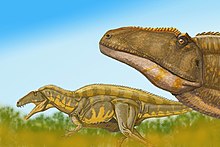
- Lourinhanosaurus
- Monolophosaurus
- Siamotyrannus
- Allosauroidea



- Appalachiosaurus
- Aviatyrannis[61]
- Bagarataan
- Bistahieversor
- Dilong[62]
- Dryptosaurus
- Eotyrannus
- Raptorex
- Stokesosaurus
- Xiongguanlong
- Yutyrannus
- Proceratosauridae[63]
- Tyrannosauridae
- Tyrannosauroidea incertae sedis
- Mögliche Tyrannosauroidea


- Beishanlong[67]
- Garudimimus
- Harpymimus
- Pelecanimimus
- Shenzhousaurus
- Ornithomimidae
- Anserimimus
- Archaeornithomimus
- Gallimimus
- Ornithomimus (einschließlich Dromiceiomimus)
- Sinornithomimus
- Struthiomimus
- Status unklar


- Haplocheirus[69]
- Alvarezsauridae

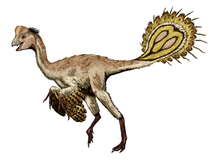

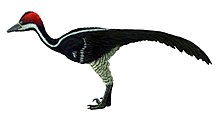
- Anchiornis
- Borogovia
- Byronosaurus
- Jinfengopteryx[71]
- Mei
- Saurornithoides
- Sinornithoides
- Sinovenator
- Tochisaurus
- Troodon
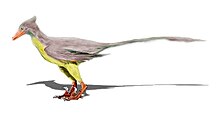



- Mahakala
- Unenlagiinae
- Microraptorinae
- Saurornitholestinae
- Velociraptorinae
- Dromaeosaurinae
- Status unklar
Avialae (Vögel i. w. S.)
[Bearbeiten | Quelltext bearbeiten]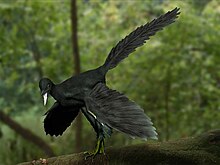
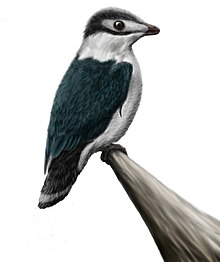
Siehe auch: Biologische Systematik, Systematik der Vögel, Gefiederte Dinosaurier
Literatur
[Bearbeiten | Quelltext bearbeiten]- David B. Weishampel, Peter Dodson, Halszka Osmólska (Hrsg.): The Dinosauria. 2nd edition. University of California Press, Berkeley, Calif. u. a. 2004, ISBN 0-520-24209-2.
- Thomas R. Holtz Jr.: Classification and Evolution of the Dinosaur Groups. In: Gregory S. Paul: The Scientific American Book of Dinosaurs. St. Martin’s Press, New York NY 2000, ISBN 0-312-26226-4.
Weblinks
[Bearbeiten | Quelltext bearbeiten]- Dinosaur Genus List (PDF; 188 kB) – Supplementary Information to Dinosaurs by Thomas R. Holtz – Stand: 31. Juli 2008. Ergänzende Informationen hier (en.; PDF-Datei; 184 kB)
- Dinosaur Supertree 2008 (Berücksichtigt 440 Arten, en.)
- A genus-level supertree of the Dinosauria (2002) (Berücksichtigt 277 Gattungen, PDF-Datei, en.; 272 kB)
- Dinosauria beim TOL (en.)
- Thomas R. Holtz: A new phylogeny of the carnivorous dinosaurs (PDF-Datei; 833 kB)
Einzelnachweise
[Bearbeiten | Quelltext bearbeiten]- ↑ Harry G. Seeley: The classification of the Dinosauria. In: Report of the Fifty-Seventh Meeting of the British Association for the Advancement of Science held at Manchester in August and September 1887. ISSN 0262-690X, S. 698–699, Digitalisat.
- ↑ K Padian: Palaeontology: Dividing the dinosaurs. In: Nature. 543. Jahrgang, 2017, S. 494–495, PMID 28332523 (nature.com).
- ↑ MG Baron, Norman DB, Barrett PM: A new hypothesis of dinosaur relationships and early dinosaur evolution. In: Nature. 543. Jahrgang, 2017, S. 501–506, PMID 28332513.
- ↑ Alexandra Grass: Paläontologie. Dino-Stammbaum neu. Wiener Zeitung, 23. März 2017, abgerufen am 17. April 2017.
- ↑ Frank Patalong: Neuordnung. Studie stellt Dinosaurier-Stammbaum in Frage. Spiegel Online, 23. März 2017, abgerufen am 17. April 2017.
- ↑ TH Huxley: On the classification of the Dinosauria with observations on the Dinosauria of the Trias. In: Q J Geol Soc. 26. Jahrgang, 1880, S. 32–51.
- ↑ Richard J. Butler, Paul Upchurch, David B. Norman: The phylogeny of the ornithischian dinosaurs. In: Journal of Systematic Palaeontology. Bd. 6, Nr. 1, 2008, ISSN 1477-2019, S. 1–40, doi:10.1017/S1477201907002271.
- ↑ Clifford A. Miles, Clark J. Miles: Skull of Minotaurasaurus ramachandrani, a new Cretaceous ankylosaur from the Gobi Desert. In: Current Science. Bd. 96, Nr. 1, 2009, ISSN 0011-3891, S. 65–70, online (PDF; 1,04 MB).
- ↑ Michael E. Burns: Taxonomic utility of ankylosaur (Dinosauria, Ornithischia) osteoderms: Glyptodontopelta mimus Ford, 2000: a test case. In: Journal of Vertebrate Paleontology. Bd. 28, Nr. 4, 2008, ISSN 0272-4634, S. 1102–1109, doi:10.1671/0272-4634-28.4.1102.
- ↑ Kenneth Carpenter, Jeff Bartlett, John Bird, Reese Barrick: Ankylosaurs from the Price River Quarries, Cedar Mountain Formation (Lower Cretaceous), east-central Utah. In: Journal of Vertebrate Paleontology. Bd. 28, Nr. 4, 2008, S. 1089–1101, doi:10.1671/0272-4634-28.4.1089.
- ↑ David C. Evans, Ryan K. Schott, Derek W. Larson, Caleb M. Brown, Michael J. Ryan: The oldest North American pachycephalosaurid and the hidden diversity of small-bodied ornithischian dinosaurs. In: Nature Communications. Bd. 4, Article Nr. 1828, 2013, doi:10.1038/ncomms2749.
- ↑ Nicholas R. Longrich, Julia Sankey, Darren Tanke: Texacephale langstoni, a new genus of pachycephalosaurid (Dinosauria: Ornithischia) from the upper Campanian Aguja Formation, southern Texas, USA. In: Cretaceous Research. Bd. 31, Nr. 2, 2010, ISSN 0195-6671, S. 274–284, doi:10.1016/j.cretres.2009.12.002.
- ↑ Yuong-Nam Lee, Michael J. Ryan, Yoshitsugu Kobayashi: The first ceratopsian dinosaur from South Korea. In: Naturwissenschaften. Bd. 98, Nr. 1, 2010, S. 39–49, doi:10.1007/s00114-010-0739-y.
- ↑ James I. Kirkland, Donald D. DeBlieux: New basal centrosaurine ceratopsian skulls from the Wahweap Formation (Middle Campanian), Grand Staircase–Escalante National Monument, southern Utah. In: Michael J. Ryan, Brenda J. Chinnery-Allgeier, David A. Eberth (Hrsg.): New Perspectives on Horned Dinosaurs. The Royal Tyrrell Museum Ceratopsian Symposium. Indiana University Press, Bloomington IN 2010, ISBN 978-0-253-35358-0, S. 117–140.
- ↑ Andrew T. McDonald, John R. Horner: New Material of „Styracosaurus“ ovatus from the Two Medicine Formation of Montana. In: Michael J. Ryan, Brenda J. Chinnery-Allgeier, David A. Eberth (Hrsg.): New Perspectives on Horned Dinosaurs. The Royal Tyrrell Museum Ceratopsian Symposium. Indiana University Press, Bloomington IN 2010, ISBN 978-0-253-35358-0, S. 156–168.
- ↑ Xing Xu, KeBai Wang, XiJin Zhao, DunJing Li: First ceratopsid dinosaur from China and its biogeographical implications. In: Chinese Science Bulletin. Bd. 55, Nr. 16, 2010, ISSN 0250-7862, S. 1631–1635, doi:10.1007/s11434-009-3614-5.
- ↑ Andrew A. Farke, Michael J. Ryan, Paul M. Barrett, Darren H. Tanke, Dennis R. Braman, Mark A. Loewen, Mark R. Graham: A new centrosaurine from the Late Cretaceous of Alberta, Canada, and the evolution of parietal ornamentation in horned dinosaurs. In: Acta Palaeontologica Polonica. Bd. 56, Nr. 4, 2011, ISSN 0567-7920, S. 691–702, doi:10.4202/app.2010.0121.
- ↑ David C. Evans, Michael J. Ryan. Cranial Anatomy of Wendiceratops pinhornensis gen. et sp. nov., a Centrosaurine Ceratopsid (Dinosauria: Ornithischia) from the Oldman Formation (Campanian), Alberta, Canada, and the Evolution of Ceratopsid Nasal Ornamentation. PLOS ONE, 2015; 10 (7): e0130007 DOI: 10.1371/journal.pone.0130007
- ↑ a b c Scott D. Sampson, Mark A. Loewen, Andrew A. Farke, Eric M. Roberts, Catherine A. Forster, Joshua A. Smith, Alan L. Titus: New Horned Dinosaurs from Utah Provide Evidence for Intracontinental Dinosaur Endemism. In: PLoS ONE. Bd. 5, Nr. 9, 2010, ISSN 1932-6203, S. e12292, doi:10.1371/journal.pone.0012292.
- ↑ Nicholas R. Longrich: Titanoceratops ouranous, a giant horned dinosaur from the Late Campanian of New Mexico. In: Cretaceous Research. Bd. 32, Nr. 3, 2011, S. 264–276, doi:10.1016/j.cretres.2010.12.007.
- ↑ Fernando E. Novas, Andrea V. Cambiaso, Alfredo Ambrioso: A new basal iguanodontian (Dinosauria, Ornithischia) from the Upper Cretaceous of Patagonia. In: Ameghiniana. Bd. 41, Nr. 1, 2004, ISSN 0002-7014, S. 75–82.
- ↑ Gregory S. Paul: The Princeton Field Guide To Dinosaurs. Princeton University Press, Princeton NJ 2010, ISBN 978-0-691-13720-9, S. 285, Online.
- ↑ Oscar A. Alcober, Ricardo N. Martinez: A new herrerasaurid (Dinosauria, Saurischia) from the Upper Triassic Ischigualasto Formation of northwestern Argentina. In: Zookeys. Bd. 63, 2010, ISSN 1313-2989, S. 55–81, doi:10.3897/zookeys.63.550.
- ↑ Adam M. Yates, Matthew F. Bonnan, Johann Neveling, Anusuya Chinsamy, Marc G. Blackbeard: A new transitional sauropodomorph dinosaur from the Early Jurassic of South Africa and the evolution of sauropod feeding and quadrupedalis. In: Proceedings of the Royal Society. Series B: Biological Sciences. Bd. 277, Nr. 1682, 2010, ISSN 0950-1193, S. 787–794, doi:10.1098/rspb.2009.1440.
- ↑ Luciano A. Leal, Sergio A. K. Azevodo, Alexander W. A. Kellner, Átila A. S. da Rosa: A new early dinosaur (Sauropodomorpha) from the Caturrita Formation (Late Triassic), Paraná Basin, Brazil. In: Zootaxa. Bd. 690, October 18 2004, ISSN 1175-5326, S. 1–24, Abstract online (PDF; 12 kB).
- ↑ John A. Whitlock: A phylogenetic analysis of Diplodocoidea (Saurischia: Sauropoda). In: Zoological Journal of the Linnean Society. Bd. 161, Nr. 4, 2011, ISSN 0024-4082, S. 872–915, doi:10.1111/j.1096-3642.2010.00665.x.
- ↑ Spencer G. Lucas, Matthew C. Herne, Andrew B. Heckert, Adrian P. Hunt, Robert M. Sullivan: Reappraisal of Seismosaurus, a Late Jurassic sauropod dinosaur from New Mexico. ( vom 8. Oktober 2019 im Internet Archive) 2004.
- ↑ John A. Whitlock: Re-evaluation of Australodocus bohetii, a putative diplodocoid sauropod from the Tendaguru Formation of Tanzania, with comment on Late Jurassic sauropod faunal diversity and palaeoecology. In: Palaeogeography, Palaeoclimatology, Palaeoecology. 309, Nr. 3/4, 2011, ISSN 0031-0182, S. 333–341, doi:10.1016/j.palaeo.2011.07.001.
- ↑ Scott A. Hocknull, Matt A. White, Travis R. Tischler, Alex G. Cook, Naomi D. Calleja, Trish Sloan, David A. Elliott: New Mid-Cretaceous (Latest Albian) Dinosaurs from Winton, Queensland, Australia. In: PLoS ONE. Bd. 4, Nr. 7, 2009, S. e6190, doi:10.1371/journal.pone.0006190.
- ↑ Hai-Lu You, Da-Qing Li: The first well-preserved Early Cretaceous brachiosaurid dinosaur in Asia. In: Proceedings of the Royal Society. Series B: Biological Sciences. Bd. 276, Nr. 1675, 2009, S. 4077–4082, doi:10.1098/rspb.2009.1278.
- ↑ Gregory S. Paul: The Princeton Field Guide To Dinosaurs. Princeton University Press, Princeton NJ u. a. 2010, ISBN 978-0-691-13720-9, S. 204, Online.
- ↑ Kristina Curry Rogers: Titanosauria. A Phylogenetic Overview. In: Kristina Curry Rogers, Jeffrey A. Wilson (Hrsg.): The Sauropods. Evolution and Paleobiology. University of California Press, Berkeley CA u. a. 2005, ISBN 0-520-24623-3, S. 50–103.
- ↑ Rodrigo Miloni Santucci, Reinaldo J. Bertini: A new titanosaur from western São Paulo State, Upper Cretaceous Bauru Group, south-east Brazil. In: Palaeontology. Bd. 49, Nr. 1, 2006, ISSN 0031-0239, S. 59–66, doi:10.1111/j.1475-4983.2005.00527.x.
- ↑ Sebastián Apesteguía: The sauropod diversity of the La Amarga Formation (Barremian), Neuquén (Argentina). In: Gondwana Research. Bd. 12, Nr. 4, 2007, ISSN 1342-937X, S. 533–546, doi:10.1016/j.gr.2007.04.007.
- ↑ Alexander Wilhelm Armin Kellner, Diogenes de Almeida Campos, Marcelo N. F. Trotta: Description of a titanosaurid caudal series from the Bauru Group, Late Cretaceous of Brazil. In: Arquivos do Museu Nacional. Rio de Janeiro. Bd. 63, Nr. 3, 2005, ISSN 0365-4508, S. 529–564, online (PDF; 1,59 MB) ( vom 18. Juli 2014 im Internet Archive).
- ↑ Hailu You, Feng Tang, Zhexi Luo: A New Basal Titanosaur (Dinosauria: Sauropoda) from the Early Cretaceous of China. In: Acta Geologica Sinica. Bd. 77, Nr. 4, 2003, ISSN 1000-9515, S. 424–429, doi:10.1111/j.1755-6724.2003.tb00123.x.
- ↑ Elizabeth M. Gomani: Sauropod dinosaurs from the Early Cretaceous of Malawi, Africa. In: Palaeontologia Electronica. Bd. 8, Nr. 1, 2005, ISSN 1094-8074, S. 1–37, online (PDF; 6,91 MB).
- ↑ José F. Bonaparte, Bernardo J. González Riga, Sebastián Apesteguía: Ligabuesaurus leanzai gen. et sp. nov. (Dinosauria, Sauropoda), a new titanosaur from the Lohan Cura Formation (Aptian, Lower Cretaceous) of Neuquén, Patagonia, Argentina. In: Cretaceous Research. Bd. 27, Nr. 3, 2006, S. 364–376, doi:10.1016/j.cretres.2005.07.004.
- ↑ Alexander W. A. Kellner, Diogenes de Almeida Campos, Sergio A. K. de Azevedo, Marcelo N. F. Trotta, Deise D. R. Henriques, Maureen M. T. Craik, Helder de Paula Silva: On a new titanosaur sauropod from the Bauru Group, Late Cretaceous of Brazil. In: Boletim do Museu Nacional. Geologia. Nr. 74, 2006, ISSN 0080-3200, S. 1–31, online (PDF; 3,31 MB) ( vom 15. März 2007 im Internet Archive).
- ↑ Xing Xu, Xiaohong Zhang, Qingwei Tan, Xijin Zhao, Lin Tan: A new titanosaurian sauropod from Late Cretaceous of Nei Mongol, China. In: Acta Geologica Sinica. Bd. 80, Nr. 1, 2006, S. 20–26, doi:10.1111/j.1755-6724.2006.tb00790.x.
- ↑ Leonardo Salgado, Ismar de Souza Carvalho: Uberabatitan ribeiroi, a new titanosaur from the Marila Formation (Bauru Group, Upper Cretaceous), Minas Gerais, Brazil. In: Palaeontology. Bd. 51, Nr. 4, 2008, S. 881–901, doi:10.1111/j.1475-4983.2008.00781.x.
- ↑ Géraldine Garcia, Sauveur Amico, François Fournier, Eudes Thouand, Xavier Valentin: A new Titanosaur genus (Dinosauria, Sauropoda) from the Late Cretaceous of southern France and its paleobiogeographic implications. In: Bulletin de la Societe Geologique de France. Bd. 181, Nr. 3, 2010, ISSN 0037-9409, S. 269–277, doi:10.2113/gssgfbull.181.3.269.
- ↑ Sebastián Apesteguía: Bonitasaura salgadoi gen. et sp. nov.: a beaked sauropod from the Late Cretaceous of Patagonia. In: Naturwissenschaften. Bd. 91, Nr. 10, 2004, S. 493–497, doi:10.1007/s00114-004-0560-6.
- ↑ Hailu You, Qiang Ji, Matthew C. Lamanna, Jinglu Li, Yinxian Li: A Titanosaurian Sauropod Dinosaur with Opisthocoelous Caudal Vertebrae from the Early Late Cretaceous of Liaoning Province, China. In: Acta Geologica Sinica. Bd. 78, Nr. 4, 2004, S. 907–911, doi:10.1111/j.1755-6724.2004.tb00212.x.
- ↑ a b Jeffrey A. Wilson, Paul Upchurch: A revision of Titanosaurus Lydekker (dinosauria ‐ sauropoda), the first dinosaur genus with a „Gondwanan“ distribution. In: Journal of Systematic Palaeontology. Bd. 1, Nr. 3, 2003, S. 125–160, doi:10.1017/S1477201903001044.
- ↑ Leonardo Salgado, Rodolfo A. Coria: Sauropods of Patagonia: systematic update and notes on global sauropod evolution. In: Virginia Tidwell, Kenneth Carpenter (Hrsg.): Thunder-lizards. The Sauropodomorph dinosaurs. Indiana University Press, Bloomington IN u. a. 2005, ISBN 0-253-34542-1, S. 430–453.
- ↑ Bernardo J. González Riga, Elena Previtera, Cecilia A. Pirrone: Malarguesaurus florenciae gen. et sp. nov., a new titanosauriform (Dinosauria, Sauropoda) from the Upper Cretaceous of Mendoza, Argentina. In: Cretaceous Research. Bd. 30, Nr. 1, 2009, S. 135–148, doi:10.1016/j.cretres.2008.06.006.
- ↑ Jorge O. Calvo, Bernardo J. González-Riga, Juan D. Porfiri: Muyelensaurus pecheni gen. et sp. nov., a new titanosaur sauropod from the Late Cretaceous of Neuquén, Patagonia, Argentina. In: Arquivos do Museu Nacional. Rio de Janeiro. Bd. 65, Nr. 4, 2007, S. 485–504, online (PDF; 1,66 MB) ( vom 31. Mai 2011 im Internet Archive).
- ↑ Fernando E. Novas, Leonardo Salgado, Jorge Calvo, Federico Agnolin: Giant titanosaur (Dinosauria, Sauropoda)from the Late Cretaceous of Patagonia. In: Revista del Museo Argentino de Ciencias Naturales. NS Bd. 7, Nr. 1, 2005, ISSN 1514-5158, S. 37–41, online (PDF; 2,38 MB) ( vom 22. August 2006 im Internet Archive).
- ↑ Jorge O. Calvo, Bernardo J. González Riga: Rinconsaurus caudamirus gen. et sp nov., a new titanosaurid (Dinosauria, Sauropoda) from the Late Cretaceous of Patagonia, Argentina. In: Revista Geológica de Chile. Bd. 30, Nr. 2, 2003, ISSN 0716-0208, S. 333–353, doi:10.4067/S0716-02082003000200011.
- ↑ Ruben D. Juárez Valieri, Jorge O. Calvo: Revision of MUCPv 204, a Senonian basal titanosaur from northern Patagonia. In: Jorge Calvo, Juan Porfiri, Bernardo González Riga, Domenica Dos Santos (Hrsg.): Paleontología y dinosaurios desde América Latina (= Serie Documentos y Testimonios. Aportes. Nr. 24). EDIUNC, Mendoza 2011, ISBN 978-950-39-0265-3, S. 143–152, online (PDF; 612,13 MB) ( vom 6. Juli 2011 im Internet Archive).
- ↑ Augustín G. Martinelli, Analía M. Forasiepi: Late Cretaceous vertebrates from Bajo de Santa Rosa (Allen Formation), Río Negro province, Argentina, with the description of a new sauropod dinosaur (Titanosauridae). In: Revista del Museo Argentino de Ciencias Naturales. NS Bd. 6, Nr. 2, 2004, S. 257–305.
- ↑ Fernando E. Novas et al.: An enigmatic plant-eating theropod from the Late Jurassic period of Chile. In: Nature. Band 522, 2015, S. 331–334, doi:10.1038/nature14307, PDF.
- ↑ a b Phil Senter: A new look at the phylogeny of Coelurosauria (Dinosauria: Theropoda). In: Journal of Systematic Palaeontology. Bd. 5, Nr. 4, 2007, S. 429–463, doi:10.1017/S1477201907002143.
- ↑ Gregory S. Paul: The Princeton Field Guide To Dinosaurs. Princeton University Press, Princeton NJ u. a. 2010, ISBN 978-0-691-13720-9, S. 77 Online.
- ↑ Xing Xu, James M. Clark, Jinyou Mo, Jonah Choiniere, Catherine A. Forster, Gregory M. Erickson, David W. E. Hone, Corwin Sullivan, David A. Eberth, Sterling Nesbitt, Qi Zhao, Rene Hernandez, Cheng-kai Jia, Feng-lu Han, Yu Guo: A Jurassic ceratosaur from China helps clarify avian digital homologies. In: Nature. Bd. 459, 2009, S. 940–944, doi:10.1038/nature08124.
- ↑ Ronan Allain, Tiengkham Xaisanavong, Philippe Richir, Bounsou Khentavong: The first definitive Asian spinosaurid (Dinosauria: Theropoda) from the early cretaceous of Laos. In: Naturwissenschaften. Bd. 99, Nr. 5, 2012, S. 369–377, doi:10.1007/s00114-012-0911-7.
- ↑ Francisco Ortega, Fernando Escaso, José L. Sanz: A bizarre, humped Carcharodontosauria (Theropoda) from the Lower Cretaceous of Spain. In: Nature. Bd. 467, 2010, S. 203–206, doi:10.1038/nature09181.
- ↑ Paul C. Sereno, Stephen L. Brusatte: Basal abelisaurid and carcharodontosaurid theropods from the Lower Cretaceous Elrhaz Formation of Niger. In: Acta Palaeontologica Polonica. Bd. 53, Nr. 1, 2008, S. 15–46, doi:10.4202/app.2008.0102.
- ↑ a b Roger B. J. Benson, Matthew T. Carrano, Stephen L. Brusatte: A new clade of archaic large-bodied predatory dinosaurs (Theropoda: Allosauroidea) that survived to the latest Mesozoic. In: Naturwissenschaften. Bd. 97, Nr. 1, 2010, S. 71–78 doi:10.1007/s00114-009-0614-x.
- ↑ Oliver W. M. Rauhut: A tyrannosauroid dinosaur from the Upper Jurassic of Portugal. In: Palaeontology. Bd. 46, Nr. 5, 2003, S. 903–910, doi:10.1111/1475-4983.00325.
- ↑ Xing Xu, Mark A. Norell, Xuewen Kuang, Xiaolin Wang, Qi Zhao, Chengkai Jia: Basal tyrannosauroids from China and evidence for protofeathers in tyrannosauroids. In: Nature. Bd. 431, 2004, S. 680–684, doi:10.1038/nature02855.
- ↑ Oliver W. M. Rauhut, Angela C. Milner, Scott Moore-Fay: Cranial osteology and phylogenetic position of the theropod dinosaur Proceratosaurus bradleyi (Woodward, 1910) from the Middle Jurassic of England. In: Zoological Journal of the Linnean Society. Bd. 158, Nr. 1, 2010, S. 155–195, doi:10.1111/j.1096-3642.2009.00591.x.
- ↑ Xing Xu, James M. Clark, Catherine A. Forster, Mark A. Norell, Gregory M. Erickson, David A. Eberth, Chengkai Jia, Qi Zhao: A basal tyrannosauroid dinosaur from the Late Jurassic of China. In: Nature. Bd. 439, 2006, S. 715–718, doi:10.1038/nature04511.
- ↑ Alexander O. Averianov, Sergei A. Krasnolutskii, Stepan V. Ivantsov: A new basal coelurosaur (Dinosauria: Theropoda) from the Middle Jurassic of Siberia. In: Proceedings of the Zoological Institute of the Russian Academy of Sciences. Bd. 314, Nr. 1, 2010, ISSN 0206-0477, S. 42–57, online (PDF; 1,03 MB).
- ↑ Stephen L. Brusatte, Mark A. Norell, Thomas D. Carr, Gregory M. Erickson, John R. Hutchinson, Amy M. Balanoff, Gabe S. Bever, Jonah N. Choiniere, Peter J. Makovicky, Xing Xu: Tyrannosaur Paleobiology: New Research on Ancient Exemplar Organisms. In: Science. Bd. 329 Nr. 5998, 2010, S. 1481–1485, doi:10.1126/science.1193304.
- ↑ Peter J. Makovicky, Daqing Li, Ke-Qin Gao, Matthew Lewin, Gregory M. Erickson, Mark A. Norell: A giant ornithomimosaur from the Early Cretaceous of China. In: Proceedings of the Royal Society. Series B: Biological Sciences. Bd. 277, Nr. 1679, 2010, S. 191–198, doi:10.1098/rspb.2009.0236.
- ↑ James M. Clark, Teresa Maryanska, Rinchen Barsbold: Therizinosauroidea. In: David B. Weishampel, Peter Dodson, Halszka Osmólska (Hrsg.): The Dinosauria. 2nd edition. University of California Press, Berkeley CA u. a. 2004, ISBN 0-520-24209-2, S. 151–164.
- ↑ Jonah N. Choiniere, Xing Xu, James M. Clark, Catherine A. Forster, Yu Guo, Fenglu Han: A Basal Alvarezsauroid Theropod from the Early Late Jurassic of Xinjiang, China. In: Science. Bd. 327, Nr. 5965, 2010, S. 571–574, doi:10.1126/science.1182143.
- ↑ Xing Xu, Qingwei Tan, Jianmin Wang, Xijin Zhao, Lin Tan: A gigantic bird-like dinosaur from the Late Cretaceous of China. In: Nature. Bd. 447, 2007, S. 844–847, doi:10.1038/nature05849.
- ↑ Alan H. Turner, Diego Pol, Julia A. Clarke, Gregory M. Erickson, Mark A. Norell: A Basal Dromaeosaurid and Size Evolution Preceding Avian Flight. In: Science. Bd. 317, Nr. 5843, 2007, S. 1378–1381, doi:10.1126/science.1144066.
- ↑ Stephen A. Czerkas, Dianshuang Zhang, Jinglu Li, Yinxian Li: Flying Dromaeosaurs. In: Sylvia J. Czerkas (Hrsg.): Feathered Dinosaurs and the Origin of Flight (= The Dinosaur Museum Journal. Bd. 1). Dinosaur Museum, Blanding UT 2002, ISBN 1-932075-01-1, S. 16–26, online (PDF; 242,32 KB).
- ↑ Xiaoting Zheng, Xing Xu, Hailu You, Qi Zhao, Zhiming Dong: A short-armed dromaeosaurid from the Jehol Group of China with implications for early dromaeosaurid evolution. In: Proceedings of the Royal Society. Series B: Biological Sciences. Bd. 277, Nr. 1679, 2010, S. 211–217, doi:10.1098/rspb.2009.1178.
- ↑ Kenneth Carpenter, Clifford Miles, Karen Cloward: New Small Theropod from the Upper Jurassic Morrison Formation of Wyoming. In: Kenneth Carpenter (Hrsg.): The carnivorous Dinosaurs. Indiana University Press, Bloomington IN u. a. 2005, ISBN 0-253-34539-1, S. 23–48.
- ↑ David E. Alexander, Enpu Gong, Larry D. Martin, David A. Burnham, Amanda R. Falk: Reply to Brougham and Brusatte: Overall anatomy confirms posture and flight model offers insight into the evolution of bird flight. In: Proceedings of the National Academy of Sciences of the United States of America. Bd. 107, Nr. 40, 2010, S. E156, doi:10.1073/pnas.1007798107.
- ↑ FuCheng Zhang, ZhongHe Zhou, Michael J. Benton: A primitive confuciusornithid bird from China and its implications for early avian flight. In: Science in China. Series D: Earth Sciences. Bd. 51, Nr. 5, 2008, ISSN 1006-9313, S. 625–639, doi:10.1007/s11430-008-0050-3.
- ↑ Hou Lianhai: Zhongguo liao xi zhong sheng dai niao lei. Liaoning ke xue ji shu chu ban she, Shenyang 2002, ISBN 7-5381-3392-5 (English Summary: Mesozoic birds from Western Liaoning in China.).